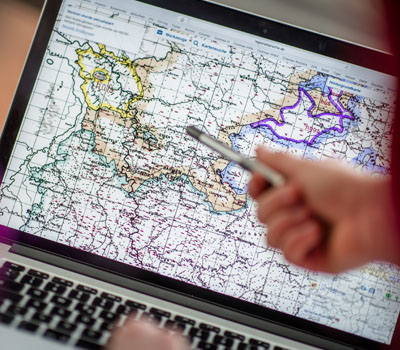Dialektatlas Mittleres Westdeutschland (DMW)
Links to the project
In light of the rapid decline of the dialectal linguistic competence especially in the north of the German language area it is the goal of the DMW, by means of a first systematic survey of current data, to document and analyse the still tangible stocks of the dialects or the manner of speaking with the maximal variation from standard of two generations of speakers in the Midwest of Germany. Through new collection of data the language varieties with the maximal variation from standard in North Rhine-Westphalia as well as the southwest of Lower Saxony and the north of Rhineland-Palatinate that have not been covered yet by modern linguistic atlases are systematically and comprehensively documented cartographically (phonetic-phonologically, morphological, syntactic and lexical). The DMW complements important existing atlas projects geographically and methodically and therefore ensures the compatibility of the data. The research findings are made accessible digitally via internet for scientific research activities of third parties as well as the interested public.
 Dialektatlas Mittleres Westdeutschland (DMW). Systematische Erhebung sowie Auswertung und Interpretation auf phonetisch-phonologischer, morphologischer, syntaktischer und lexikalischer Ebene
Dialektatlas Mittleres Westdeutschland (DMW). Systematische Erhebung sowie Auswertung und Interpretation auf phonetisch-phonologischer, morphologischer, syntaktischer und lexikalischer EbeneDialektatlas Mittleres Westdeutschland (DMW)
Host Academy
North Rhine-Westphalian Academy of Sciences, Humanities and the Arts
Location and federal state
Siegen, North Rhine-Westphalia
Type
German Dictionaries; Historical Dictionaries; Dictionaries of Regional and Specialist German varieties
Project number
I.A.24
Because of the heterogeneous linguistic characteristics in the study area one can estimate different degrees of proximity to the dialects or variation from standard, that for the first time are systematically captured, structurally analysed and compared to the DMW within a limited period of time. To capture the dynamics of the language change in the area of the DMW, data from two generations is collected. It can be assumed, that the strongest degree of dialects will mainly be found in the older generation, while the generations of children and gradnchildren use weaker forms of dialects set between dialect and standard language that are not only bound spatially but also socially/situationally. Especially the child generation of the today 30- to 40 years old people, must be surveyed as well, to seize the unique opportunity to document the linguistic conversion in comparison with other generations and evaluate it in combination with language biographical data.
Back to overview
